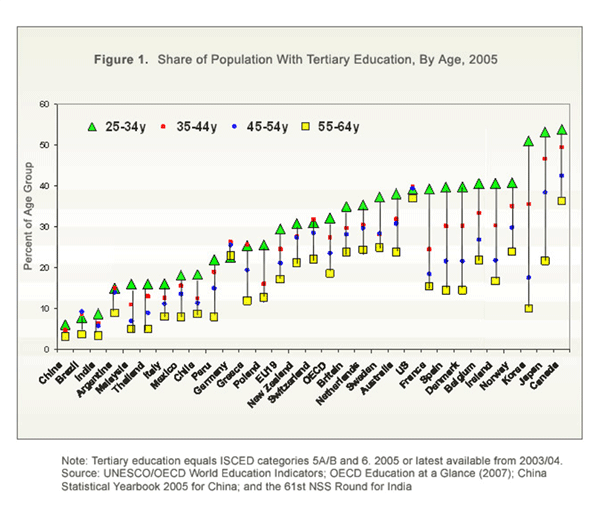America rose to global economic prominence, superpower status and victory in the Cold War on the shoulders of the most highly skilled workforce in the world. However, America’s global “skills leadership” is now under challenge.
An increasingly vicious combination of long-term trends in the form of retiring baby boomers and stagnating US educational attainment, combined with increasingly restrictive laws on high-skilled immigration increasingly undermines US position. This will seriously jeopardise long-term economic growth opportunities, especially for US high-tech sectors.
Ageing US baby boomers were the best-educated workers in the world when they entered the workforce 30-some years ago. Building on visionary policies like the GI Bill of 1944, college-level graduation rates for US baby boomers reached almost 40 per cent during this period, far exceeding graduation rates of 20 to 25 per cent enjoyed by contemporary British, French, German or Japanese baby boom generations in the late 1960s and 1970s. The year 2008 is the first in which Americans born after World War II can retire with public pensions - hence, the loss of large numbers of well-educated baby boomers will be more severely felt in the United States than among other major industrialised economies.
Advertisement
Another long-term worry is the stagnation seen in the average educational attainment of Americans in recent decades. Almost uniquely in the Organization for Economic Cooperation and Development, the tertiary-level graduation rates among present-day US labour market entrants, aged 25 to 34, is the same as that of their baby boomer parents, aged 55 to 64 - stuck below 40 per cent. Hence, there’s a risk in coming years that as many high-skilled Americans will retire as will enter the workforce. The century-long continuous compositional skills improvement of America’s workforce may soon end.
Moreover, while America failed to continue to improve broad educational standards during the last 30 years, the rest of the world has not stood still. Today, more than 50 per cent of young Canadians, Japanese and Koreans obtain tertiary education representing a vast educational advancement relative to their parents’ generation. American labour market entrants today barely make the global skills top-10 list. As a direct result, for the first time in generations, the US risks becoming less skill-abundant than an increasing number of its global economic competitors. (See Figure 1)

Figure 1. Share of population with tertiary education, by age, 2005. Enlarge image
US and Canadian baby boomers, aged 55 to 64, were indeed the “brightest kids on the global trading block,” when they entered the workforce and rapidly globalising marketplace. Thus baby boomers were ready to take advantage of trade liberalisation and the opening of global markets during the last part of the 20th century, far less true for today’s American youth.
Policymakers cannot stop the greying of the US population or the imminent retirement of baby boomers. Similarly, successful overhaul of the US education sector could only begin to reverse more than 30 years of educational stagnation over the long term. Improving the education system is hardly a realistic or quick solution to forestalling broad skill shortages in the US economy over the next decade.
Advertisement
US policymakers can only hope to counter these long-term phenomena in a timely manner by reforming high-skilled immigration policies and facilitating the continued and increasingly economically necessary inflow of high-skilled workers from abroad.
Instead, US high-skilled immigration policies have in recent years become tangibly more restrictive - waylaid by wider congressional gridlock on immigration and political emphasis on indiscriminate enforcement. This restrictiveness is relative to earlier periods in US history and, more importantly, other industrialised countries today.
In April 2008, for instance, about half of 163,000 US businesses wishing to hire a foreign high-skilled worker on H-1B visas were denied this opportunity by the annual quota of 85,000 - 65,000 plus 20,000 available to foreign graduates with advanced degrees from US universities - available visas.
Discuss in our Forums
See what other readers are saying about this article!
Click here to read & post comments.
2 posts so far.